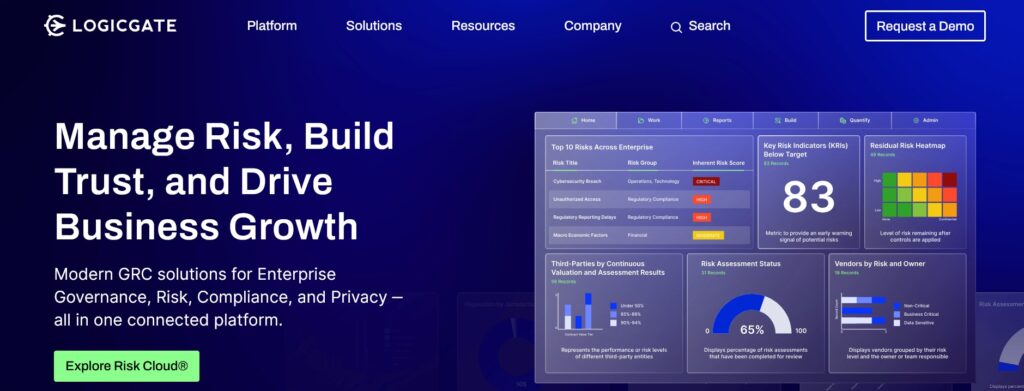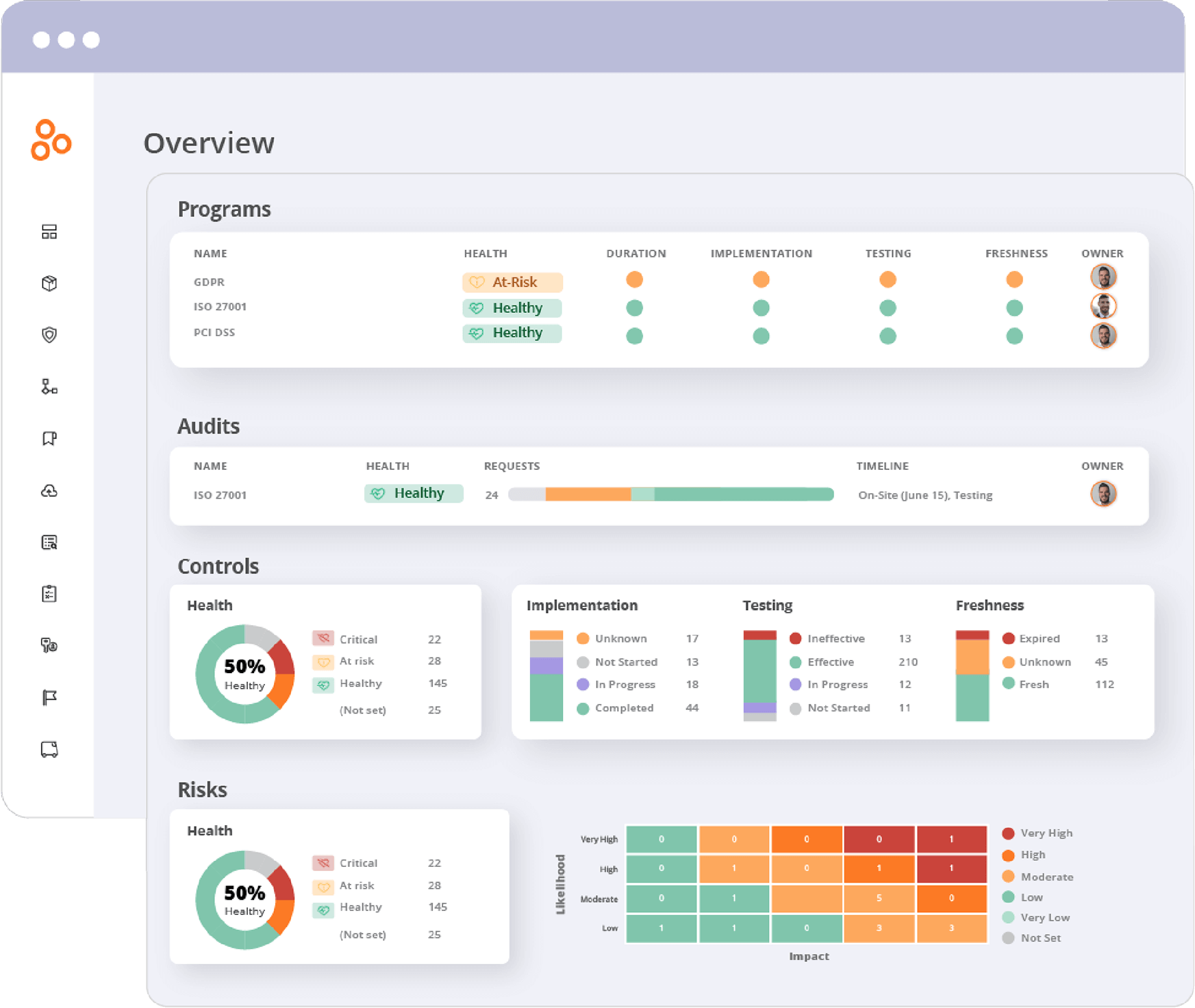Governance, Risk, and Compliance (GRC) platforms are necessary for organizations to manage their risks while meeting the compliance requirements of different standards, all using internal policies and strong governance. Using these platforms, you can map risks, automate workflows, and generate reports. With growing risks and compliance, more companies are increasingly moving towards these tools, as they provide comprehensive control and visibility.
A popular GRC platform is LogicGate. This is a no-code platform that allows organizations to build GRC workflows through simple drag-and-drop tools. Its many features make it highly customizable and scalable, and hence, it is ideal for organizations of all sizes.
Despite these advantages, Logicgate has a steep learning curve, and some users have reported that its UI is less intuitive when compared to other platforms. If you share this opinion, it’s time to look at its competitors and alternatives.
In this article, we have come up with the top tools that are similar to or better than LogicGate in some aspects.
1. AuditBoard
AuditBoard is a connected risk platform that empowers your compliance and audit teams to identify vulnerabilities and fix them before they lead to financial loss and operational inefficiency. I found that at the same time, it also enables them to find strategic opportunities and improve compliance and security through a single pane.
Source: AuditBoard
Key Features
- Visualizes and addresses every known risk in your organization.
- Reduces manual effort through automated workflows.
- Delivers insights that tackle risk and compliance challenges.
- Its GRC-trained AI converts time-intensive tasks into actionable workflows.
- Generates flexible reports for strategic decision-making.
- Its many integrations and APIs streamline data collection and task management.
Overall, AuditBoard is a comprehensive GRC platform that works well for most organizations.
Pros:
- Intuitive user interface.
- Strong automation.
- Good customer support.
- Real-time audit logs.
- Out-of-the-box reports and templates.
Cons:
- Setup requires more work.
2. Vanta
Vanta is an automation-driven GRC platform that enables your team to manage risk and compliance through a single interface. Its AI agents and automated workflows collect evidence, identify gaps, monitor security and vendor risks, and more. I noted that the highlight is that throughout, administrators have complete control and visibility.
Source: Vanta
Key Features
- Collects evidence for 35+ compliance frameworks, like SOC 2, ISO 27001, and more.
- Continuously monitors for risks and provides real-time alerts.
- Handles vendor reviews to save time and effort.
- Its automated controls and point-in-time status checks provide visibility into the health of your programs.
- Integrates well with 375+ applications.
- Simplifies policy creation with templates for every framework.
- Maps your custom controls with Vanta’s library of automated tests for continuous monitoring.
In all, Vanta can automate and scale your compliance requirements with little time and effort.
Pros:
- Clean and intuitive interface.
- Multiple integrations.
- Continuous security monitoring.
- Vendor risk management.
- Automated evidence gathering.
Cons:
- Fewer options to customize controls.
Vanta offers Core and Plus plans for startups, and three plans for enterprises: Growth, Scale, and Enterprise.
3. Drata
Drata is an AI-native security and compliance automation platform that helps manage risks. It centralizes risk, governance, and compliance in a single platform. Its integrated risk management features provide complete visibility into vendor, internal, and external risks. I learned that its AI-driven workflows centralize tracking and reduce exposure to risks.
Source: Drata
Key Features
- Allows you to automate governance, as you can assign ownership to people and track their progress.
- Its automated workflows help speed up responses.
- Automates evidence collection and mapping.
- Customizing workflows and even building your own controls and tests is easy.
- Prepares you for the audits of multiple frameworks.
Overall, Drata’s automation and deep integration enable teams to stay on top of risks while meeting compliance requirements.
Pros:
- Real-time monitoring.
- Ongoing risk readiness.
- Integration with the most well-known platforms.
- Automated workflows that save time and effort.
- AI-powered assurance through questionnaires and control mapping.
Cons:
- Less suited for legacy systems.
4. Secureframe
Secureframe is another LogicGate alternative as it also has advanced automation capabilities to improve security and reduce risks. Its AI-powered features can handle end-to-end compliance and even provide guidance to remediate security vulnerabilities. I discovered that Secureframe can also connect you with in-house compliance experts and former auditors who can offer expert recommendations.
Source: Secureframe
Key Features
- Continuously tracks assets and employees through a single pane.
- Manages failing controls and provides remediation guidance.
- Generates readiness reports to help you stay on top of compliance requirements.
- Support vendor access and management.
- Highly scalable, as you can add more frameworks easily.
In all, Secureframe simplifies compliance through its automated features and backs it with expert suggestions and services like pen testing.
Pros:
- Easy onboarding makes it ideal for technical and non-technical teams.
- Comprehensive service bundle to support ongoing compliance.
- Expert guidance and recommendations.
- Support for multiple frameworks.
- Its automation workflows save time and effort.
Cons:
- Fewer customization options.
- Some integrations can be inconsistent.
Secureframe offers two plans – Fundamentals and Complete.
5. Sprinto
Sprinto is a cloud-native compliance tool that eases the process of compliance while supporting internal and external audits. I observed that geared largely for tech companies, this platform can handle multiple regulatory frameworks, like SOC 2, HIPAA, PCI-DSS, and more.
Source: Sprinto
Key Features
- It comes with pre-approved and auditor-grade compliance programs that can be launched within minutes.
- The adaptive automation capabilities continuously capture evidence and store them in an audit-friendly format.
- Backed by support from compliance experts and auditors.
- Scales quickly to meet your growing needs.
- It is compatible with 200+ cloud services.
In all, Sprinto is a good choice for organizations that need out-of-the-box controls for quick compliance.
Pros:
- Quick to set up, as it requires no code and minimal control mapping.
- Strong and easy-to-use UI.
- Support from experts.
- Wide compliance with different frameworks.
Cons:
- Not ideal for on-premise deployments.
6. Hyperproof
Hyperproof is another popular GRC platform that automates controls, meets compliance requirements, and integrates risk operations to protect your business from operational and financial losses. I noticed that its many features also improve efficiency and reduce time and effort.
Source: Hyperproof
Key Features
- Allows you to reuse controls across multiple frameworks to make it easy to adapt to emerging regulations.
- Scales well across multiple locations and entities across your organization to reduce control redundancy.
- Automates and orchestrates controls to help organizations meet their compliance goals.
- It stores all security responses, policies, and certifications in a centralized location so that it can be a single source of truth.
- Integrates risk flows to make it easy for your teams to monitor real-time risks and quickly resolve them.
In all, Hyperproof is a compliance-focused platform that works best for businesses requiring fast and collaborative workflows.
Pros:
- Low learning curve.
- Clean and easy-to-use UI.
- Quick set up and minimal training.
- Reusable audit evidence.
- Excellent customer support.
Cons:
- Limited report customization.
7. Onspring
Onspring GRC brings all your connected systems together through efficient processes and strategies to give you complete control and visibility. In turn, this control also allows you to implement the required policies and take the necessary action to safeguard operations from many kinds of threats.
Source: Onspring
Key Features
- Creates a comprehensive risk register, so you can use this as a basis to automate risk assessments.
- Generates live dashboards containing key metrics, risk scores, and audit activities.
- Automates many processes and workflows related to compliance testing and risk scoring.
- Its control library maps all regulations related to risks and policies.
- Handles the complete policy lifecycle management.
I found that in all, Onspring is a no-code GRC platform that offers workflows for managing risks, compliance, audits, vendors, policies, and business continuity.
Pros:
- Comes with a drag-and-drop form and report builder for quick setup.
- Comprehensive workflow automations.
- Supports vendor risk management and third-party tracking.
- Creates live dashboards with relevant data.
Cons:
- The report interface has a learning curve.
Thus, these are the different LogicGate competitors and alternatives. As you can see, each platform has some unique features that cater to specific organizations and use cases.
Choosing the Right LogicGate Alternative
Selecting the right GRC platform as an alternative to LogicGate depends on factors like your organization’s size, needs, and compliance. Below is a guide on which tools to pick for specific scenarios.
Company Size
The size of your company has a big bearing on the choice of your GRC tool. In general, smaller companies have fewer compliance requirements, and hence, tools with specific or limited features work well. Moreover, these tools are often more affordable than those with extensive features.
For example, tools like Sprinto and Vanta are ideal for small businesses because they are quick to deploy and offer automated compliance. Hyproof and Onspring are good choices for medium-sized businesses, as they balance customization with ease of use. Finally, tools like AuditBoard and Drata work well for large enterprises that require advanced risk mapping and extensive integrations.
Customization
Another aspect is the level of customization you need. Again, this depends on the number of compliance frameworks you want to meet, with more customization required for multiple frameworks, especially when you want to reuse controls.
For those organizations that require minimal customization and can do well with a structured tool with pre-built templates, go for tools like Sprinto and Drata, as they can get you up and running quickly. On the other hand, if you need high levels of customization, Onspring is a good choice, as it comes with a flexible drag-and-drop builder.
Budgets
Cost is an important consideration, especially in today’s environments where organizations have to meet more compliance frameworks with fewer resources. Vanta and Sprinto offer lower pricing tiers for budget-conscious companies, while Onspring and Hyperproof provide good value for money, and even come with additional support and expert guidance. If you need enterprise-grade features and don’t mind paying extra, Drata and AuditBoard are good choices.
Based on your specific needs, you can select the tool that works best for you.
Final Thoughts
To conclude, LogicGate is a popular GRC platform, but it may not be ideal for all organizations and use cases. This is where it helps to explore LogicGate alternatives like Drata, Vanta, Onspring, Hyperproof, Secureframe, Auditboard, and Sprinto.
Browse through our compliance software for a more detailed review of each of these tools, as they can come in handy for picking the one that best meets your needs.







